The Big Dipper constellation: number of stars, names, myth, appearance, diagram, pictures and videos
The Big Dipper is a widely recognized constellation. Its bright stars make it easily visible to the naked eye. It has long served as a navigational guide for travelers and has been extensively studied by scientists. The Big Dipper is frequently observed, leading astronomers to make fascinating discoveries and gain a deeper understanding of the universe.
The Big Dipper: Appearance, Description, and Characteristics
The Big Dipper is the third largest constellation in the sky. Covering over 3% of the celestial sphere, it spans an impressive 1279.66 square degrees. This cluster of stars revolves around Polaris, the North Star, ensuring that it remains visible above the horizon throughout the year.
Comprised of seven bright stars, the Big Dipper forms the shape of a large ladle or bucket with a long handle. In Latin, this constellation is known as Ursa Major and is abbreviated as UMa.
Given its considerable size, it is not surprising that the Big Dipper shares its borders with numerous other constellations. Some of its neighbors include Draco, Camelopardalis, Coma Berenices, Canes Venatici, and Leo.
In Russia, the constellation is always visible throughout the year, but its stars shine particularly brightly in April compared to other months. By observing the movements of the Big Dipper, one can determine the month and approximate date. Interestingly, in ancient China, people had the ability to tell time by observing the position of the handle of the Bucket.
How to locate the Big Dipper in the night sky?
Locating any constellation in the sky can be quite challenging without specialized equipment. However, finding the Big Dipper is relatively easy due to its distinct shape. Once a person locates this group of stars, the problem is solved.
In late summer and early fall, the Big Dipper can be found in the northern part of the night sky. For optimal viewing, it is recommended to wait until nighttime and venture outside of urban areas to minimize light pollution and enhance stargazing conditions.
During the autumn season, the Big Dipper is positioned high in the sky and appears horizontally. The stars that form this asterism are bright enough to be easily seen by the naked eye, and the brain automatically connects them in a straight line, creating the desired object.
Due to the rotation of the Earth around the Sun and its axis, the configuration of constellations in the night sky changes gradually when observed from a single point. This means that between January and February, the Big Dipper undergoes a gradual circular rotation: The bucket, which starts off in a horizontal position, tilts downward along with the handle. Additionally, the overall position of the cluster gradually shifts towards the northeast.
During the spring, it becomes more challenging to locate the Big Dipper in the night sky. This is because, during this time, the asterism is finally turned “lid up”, making it less noticeable to someone who is unfamiliar with it.
The Ancient Depiction of the Big Dipper
The Big Dipper holds a significant place in human history as one of the oldest known constellations. It has been referenced by numerous civilizations that have inhabited our planet over the centuries. Its origins can be traced back to ancient India, where it was known as “Sapta Rishi,” meaning “seven sages,” due to its seven prominent stars that form the shape of a dipper. The Chinese also recognized the Big Dipper and even used its position in the sky as a means to determine time.
A captivating tale was created by the ancient Greeks to explain the formation of the Big Dipper. In Greek mythology, Zeus, the king of the gods, was known for his infatuation with beautiful women. Callisto, the daughter of the king of Arcadia, caught his eye, and like many before her, she became the object of his affection. However, Zeus’s wife Hera discovered the affair and sought revenge. To protect Callisto from Hera’s wrath, Zeus transformed her into a bear and placed her in the sky, where she would be safe.
The Indians also recognized the figure of a bear in the stars, but their interpretation differed slightly. According to their beliefs, the bear is represented by four stars arranged in the shape of a trapezoid. The handle of the Big Dipper, on the other hand, is seen as three hunters chasing after the bear. Aliot leads the pursuit, armed with a bow, while Mitzar carries a cauldron. Benetnash brings up the rear, carrying a bundle of brushwood to start a fire.
Stars in the Great Bear
The Great Bear is composed of a remarkable number of stars. However, within its constellation, the Plough, there are only seven celestial bodies that form a distinctive shape. Advances in technology enable astronomers to continuously observe these stars and gather essential data. The Plough constellation includes:
- Dubhe – serves as the alpha star and is recognized as the second brightest star in the constellation. Detailed research has revealed that Dubhe is comprised of two stars: the main sequence and the orange giant.
- Merak is the beta star of the cluster. Although not the most prominent in the night sky, it radiates 69 times brighter than the Sun.
- Fekda – a star positioned at the lower part of the Plough, below the handle.
- Megretz is the least luminous star in the Great Bear.
- Aliot – the most prominent star in the cluster, easily visible in the night sky.
- Mizar – not very visible because the nearby star Alcor is significantly brighter.
- Alkaid – the farthest luminary from the rest of the group, located at the tip of the handle of the Big Dipper.
In addition to the seven stars in the asterism, the constellation contains approximately 125 more stars. However, only a few dozen of them can be seen with the naked eye. The most notable ones are the three stars to the right of the Dubhe-Merak pair, which form a triangle. In the lower right corner of the Big Dipper, there is a similar formation composed of the stars lambda, mu, and psi.
- Polaris;
- Cassiopeia;
- the Leo constellation is in close proximity;
- the stars Capella and Arcturus;
- the Gemini constellation;
- the Virgo constellation.
If you have knowledge of the direction in which these entities are positioned in relation to the Big Dipper, locating them becomes a simple task.
The assortment of items in the Big Dipper
The majority of the objects within the Big Dipper can only be observed using professional equipment. When using an amateur telescope, one can only spot the Owl Nebula, which is designated as M97. Adjacent to it is the star Merak.
Star Systems
The region of the celestial sphere that contains the constellation Ursa Major is home to approximately 1,500 galaxies that are of particular interest to astronomers. Given that this cluster is situated within the Milky Way, the majority of these galaxies can be observed using a professional telescope.
Galaxies M82, M81, and M101, also known as the Cigar, Bode, and Vertushka galaxies, respectively, are located approximately 12 million light years away from Earth. The Cigar galaxy is renowned for its stunning appearance, with violet-blue arms and a distinct, luminous blue center resembling a sphere.
The spiral-shaped Vertuska galaxy possesses elongated, curved tails adorned with numerous luminous objects. Astronomers often liken these objects to fireworks, as they resemble bursts of exploding pyrotechnics.
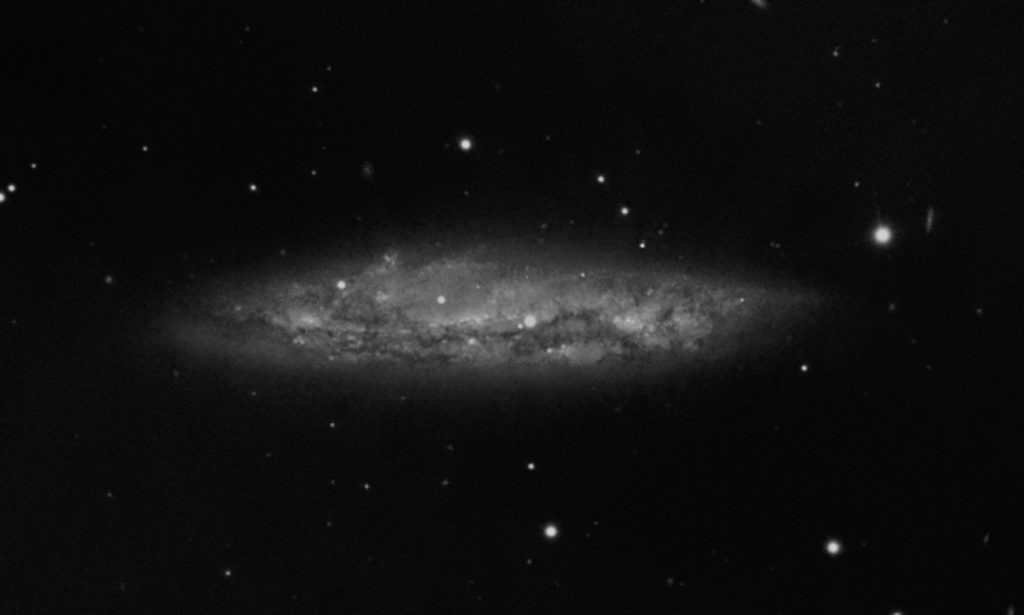
The M108 galaxy is situated adjacent to the star Merak. Its center remains obscured due to the presence of dust clouds, which also dampen its luminosity, measuring approximately 12m when observed from Earth.
In close proximity to the Fekda luminary, one can spot the M109 Dustman galaxy. This particular galaxy is renowned for its challenging visibility, as its glow is often overshadowed by nearby stars.
Astronomers consistently make new discoveries of galaxies with distinct characteristics while observing the region where the White Bear is located. Its favorable position in the sky allows for the observation of even the most remote objects.
Due to the constant movement of cosmic objects, the Big Dipper can be found in different parts of the night sky throughout the year. During the autumn months, many stars are not visible to the naked eye. However, the constellation’s famous group of seven stars is an exception. Although they may not shine as brightly from September to November, they can still be seen without the aid of a telescope.
In the autumn, the Big Dipper can be found in the northern part of the sky, below Polaris. The dipper appears as if it is tilted with its handle pointing towards the west. To the east, you can spot the constellation Pleiades, with the bright star Aldebaran nearby. In the northeast, you will find the prominent stars that form the constellation Gemini.
However, not all star clusters are visible during the autumn season. In Russia, the constellations Virgo and Leo are located below the horizon, and the Eagle constellation is only faintly visible behind the Big Dipper in the western region.
In the autumn sky, the constellations are regarded as the most luminous:
These groupings can be observed during the nighttime without the need for any specialized equipment. In order to study other celestial objects, astronomers rely on high-powered telescopes that have the ability to bring the stars and galaxies of interest into closer view. For instance, the Hubble telescope is capable of observing over a thousand galaxies in the stellar region of the Big Dipper. This allows scientists to work continuously without having to take seasonal breaks.
Debunking Myths: The True Origins of the Big Dipper
There have been numerous myths and legends surrounding the creation of the famous constellation known as the Big Dipper. While the Greek legend involving the girl Callisto and Zeus is the most well-known, there is another intriguing version of the myth.
In this alternate tale, the goddess Artemis, known for her love of hunting, often ventured into the forest in search of various game. Accompanying her were a group of exceptionally beautiful young girls, among whom Callisto stood out as the most radiant.
Zeus, captivated by Callisto’s beauty, devised a plan to win her affections. He disguised himself as Artemis and approached Callisto. Eventually, their encounter led to the birth of a son named Arcades. However, Zeus’s wife Hera discovered his deceitful act and, consumed by anger, transformed Callisto into a bear, stripping her of her former allure.
Arkad grew up and transformed into a skilled hunter. On one of his hunting expeditions, he unexpectedly encountered his mother, who had taken the form of a bear. Unaware of her true identity, Arkad prepared to shoot her with his trusty bow. However, Zeus intervened and transformed both of them into radiant constellations that now adorn the night sky. Callisto became the well-known Big Dipper, while Arkad became the lesser-known Little Dipper.
Ever since that fateful moment, these two constellations have remained inseparable in the celestial expanse, seemingly watching over one another. Their close proximity in the night sky facilitates the discovery of both constellations, as they appear to be keeping an eye out for each other. Thus, if an observer manages to locate one constellation, finding the other becomes a simple task.
Optimal Time for Observing the Big Dipper
For a clear view of the Big Dipper within the borders of the Russian Federation, it is recommended to venture outside urban areas where artificial lighting does not obstruct celestial objects. The ideal period for observing this constellation falls between March and April.
During these months, the Big Dipper ascends to its highest point in the sky, reaching maximum luminosity around 11:00 PM daily. By looking upwards, one can easily locate the iconic Dipper formation. With even a basic pair of binoculars, it becomes possible to observe not only the seven primary stars, but also nearby objects.
In contrast, the autumn months are the least favorable for observing the Big Dipper. The asterism appears dimmer during this time, and without the aid of a telescope, it becomes difficult to discern the neighboring stars associated with the constellation.
Thanks to its impressive luminosity, the Ursa Major constellation has served as a reliable navigational point for centuries. Depending on the time of year, experienced explorers of the celestial sphere could ascertain the position of the cardinal directions and proceed accordingly.
Most importantly, Ursa Major aids in locating Polaris, the North Star. By mentally drawing a straight line from this celestial guide to the Earth’s surface, one can accurately determine the north direction using this perpendicular line.
Once the north direction is known, one can immediately discern the other cardinal directions: south – behind, west – on the left, east – on the right. Additional stars such as Arcturus and Spica, found in the southern region of the sky, provide further orientation in space. During the Middle Ages, seafarers relied on these stars to precisely chart their course while sailing under the night sky.
One of the benefits of using the Big Dipper as a point of reference is its expansive coverage in the night sky. Even if the weather is cloudy, it is highly likely that at least a portion of the constellation will still be visible. This is sufficient to ascertain the position of the North Star.
Fascinating footage showcasing the Big Dipper
If you come across any mistakes, kindly mark the text and hit Ctrl+Enter.
Large Bear PNG image
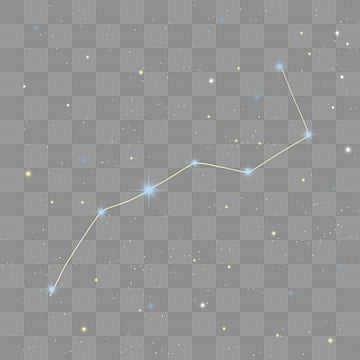
The constellation of Ursa Major emerged in the night sky.
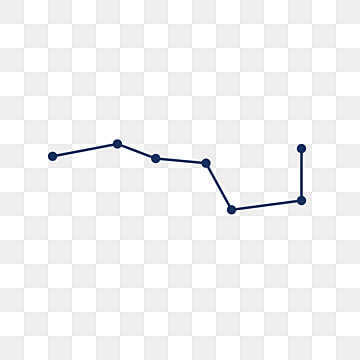
The outline style of the Big Dipper constellation

A hand-painted illustration capturing the essence of the Big Dipper constellation in a unique blue line drawing, reminiscent of ice crystals.

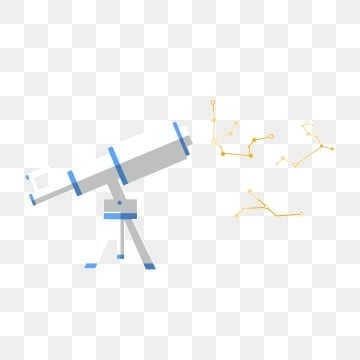
telescope is a piece of equipment used in astronomy to observe objects in the sky

Universe of paper spaceships

The appearance of the Big Dipper constellation in the night sky can be compared to the serene and graceful silhouette of a yoga practitioner. The romantic ambiance created by the twinkling stars adds to the enchantment of this celestial phenomenon.
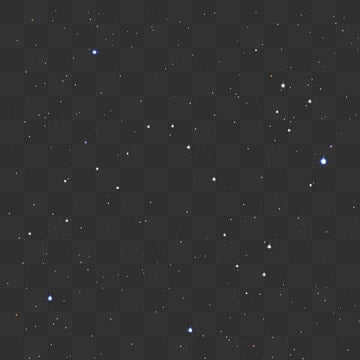
Space and astrophysics flat icons collection
Astrophysics Flat Icons Collection
Ursa Major with sparkling stars
space line blue line style dark net generally small icon
photos of celestial elements
New Year’s Day 2022 BIG SALE! Final day-last day discount up to 85% off
Join the pngtree design team
Upload your first copyrighted design. Get $5 off designer coupons
2017-2022 Pngtree -All rights reserved.
Welcome to Pngtree
Sign in to download for free
Great to have you back!
Sign in to see more
By creating an account I agree to pngtree’s Terms of Service,
Download free commercial resources worldwide
Sign up to see more
Start your trial for free
By agreeing to pngtree’s Terms of Service, I will create an account
Thank you!
Log in to begin downloading
It is an honor to work hard.
Why not give this a try? Take a 2-minute break, then resume downloading later.
You have hit the download limit of 200 for today.
Please return tomorrow to continue downloading.
Unfortunately, your download speed is too fast, and the system suspects the presence of automated activity.
Please provide the necessary identification information to verify your transaction.
Shining Celebrities of the Large Bear’s Pail.
Not all that sparkles is counterfeit
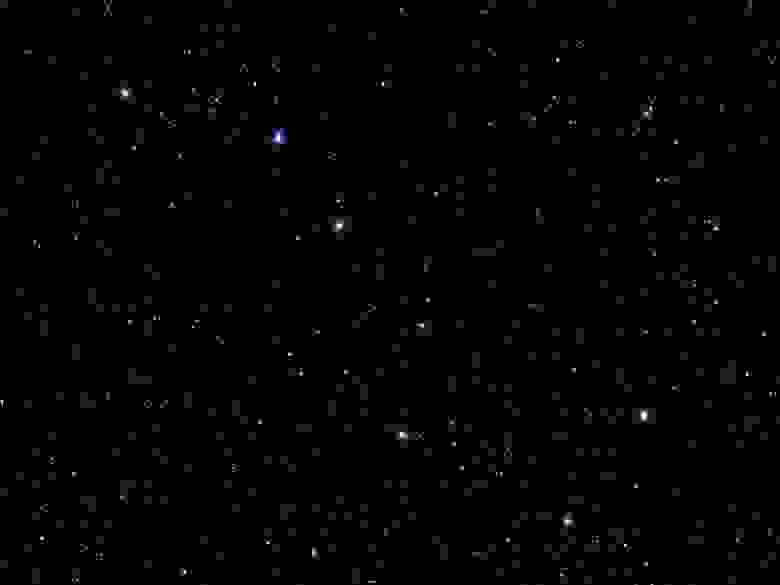
The constellation of the Big Dipper is well-known for its use in navigation. It is the easiest way to locate Polaris and determine the direction of the north. Additionally, the image of the Bear holds a certain sacred significance, although not everyone is acquainted with the legend behind this constellation.
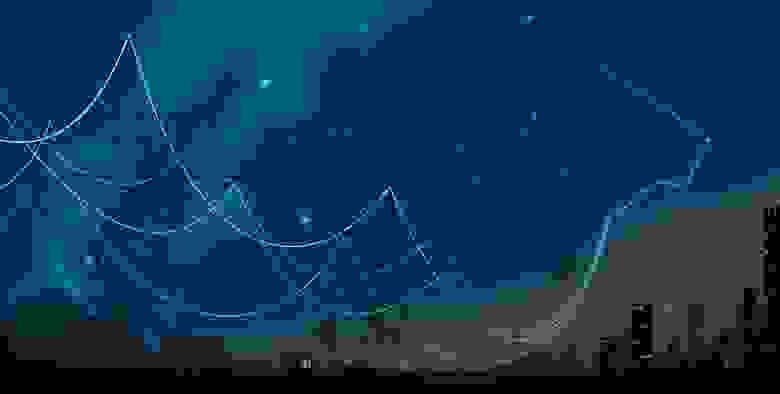
The constellation of the Big Bear is also known as the “Big Dipper”, suggesting that there is also a “Small Dipper” in the sky, referring to the constellation of the Little Bear. However, there are larger buckets of stars in the night sky, so it is not necessary to be too familiar with the Little Bear.
Each star in the Big Dipper has its own name and is designated by a Greek letter:
α (alpha) is known as Dubhe.
β is called Merak.
γ (gamma) is known as Thekda or Fad.
δ (delta) is called Megretz.
ε (epsilon) is known as Aliot.
ζ (zeta) is called Mitzar.
η (eta) is known as Benetnash or Alkaid.
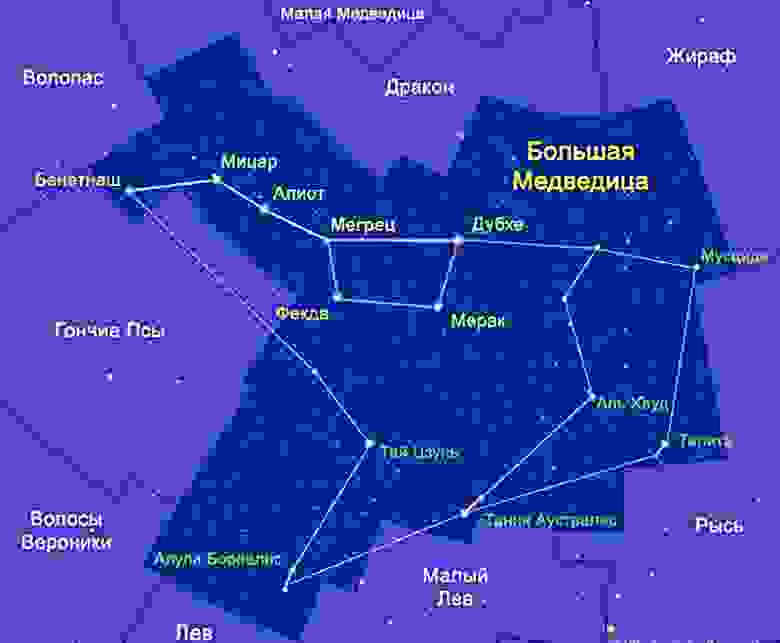
The constellation Ursa Major, also known as the Great Bear, consists of more than just the seven stars that make up the Big Dipper. While the Big Dipper represents the torso and tail of the bear, there are also the head, front paws, hind paws, and the space between the paws, making it a much larger constellation. In fact, Ursa Major is the third largest constellation in the night sky. It contains a total of 126 stars that can be seen with the naked eye, although you would need to observe them from a location far away from city lights to fully appreciate their beauty.
However, today I would like to discuss the stars in the bucket. And there is a specific reason for that. In my previous article, I mentioned a binary star called Albireo, which has captivated scientists due to its dual nature. The debate surrounding this star revolves around its distance from Earth and the proximity between its two components. Some scientists argue that both components are relatively close to us and are also close to each other. On the other hand, there are those who believe that one of the stars is significantly farther away from the other, and their apparent proximity in the night sky is simply an illusion. In reality, these two stars are separated by vast distances, preventing gravitational forces from merging them into a single system. This discussion reminded one of my readers of a similar pair of stars in the constellation Ursa Major – Mizar and Alcor. While delving into this example, I stumbled upon some fascinating information that I simply cannot keep to myself.
Let’s talk about constellations in general
The majority of stars grouped together in what we refer to as “constellations” are not actually connected to one another. This is due to our imagination, which is likely unique to us in the entire universe. It would seem strange, or even foolish, to explain to other beings about constellations – how three stars make up Orion’s belt, or how four stars create the shape of Pegasus, a mythical winged horse. There is no scientific basis for this. Furthermore, we sometimes combine stars in a constellation that are light years apart, and there may even be stars that no longer exist – they died long ago, but we have yet to observe their absence.
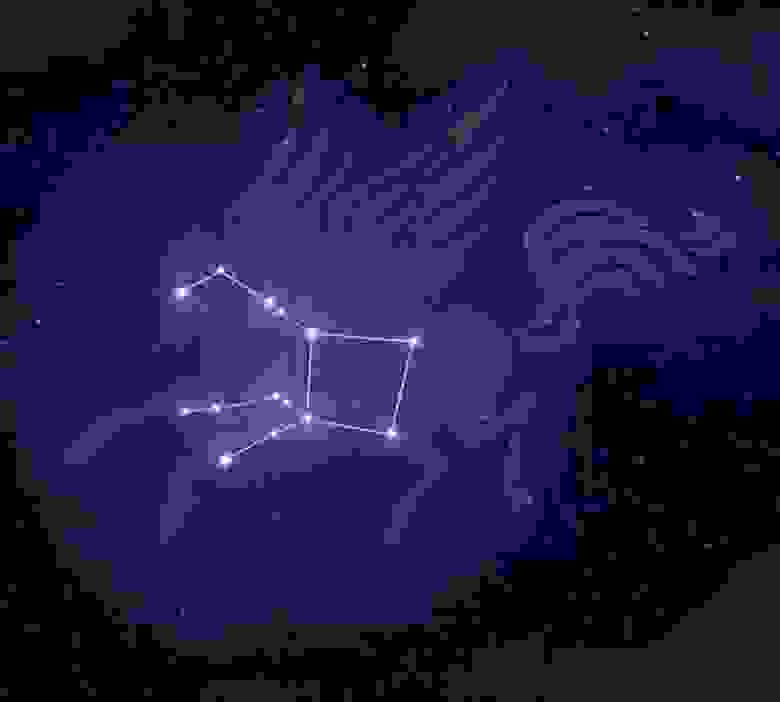
That’s what is often said, pointing to the constellation of Ursa Major. Today someone told me the same thing – these stars may appear close to each other in the sky, but in reality, they are at very different distances. Some are light years away, while others are “millions of light years” away.
I may have missed the part about the “millions” (since stars visible to the naked eye don’t exist millions of light years away), but I agree with the rest. So, I decided to investigate.
Now, let’s shift our attention to the most well-liked spot on the ladle – the curve of its handle, where a rather bright star called Mitzar (horse) glimmers, and right next to it, there is a noticeably fainter star – Alkor (rider). In ancient times, Arab archers wouldn’t consider men who couldn’t see these two stars separately. What was the point of having them? – They were only useful for shooting arrows. However, even today, the ability to clearly see the small Alcor next to the bright Mitzar is an indication of good eyesight.
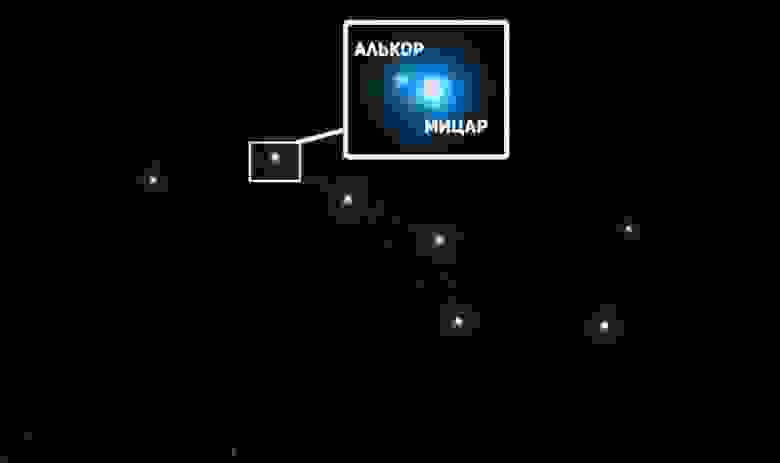
These celestial bodies are positioned at an angular separation of 12 minutes of arc, which is slightly less than half of the lunar disk. However, subjectively, it appears that the stars are in close proximity, with some even appearing to merge into one. This proximity is significant for astronomers. The typical distance between the components of a binary system is not measured in minutes of arc, but rather in seconds and fractions of seconds of arc. This difference in scale, which is two or three orders of magnitude smaller, suggests the possibility that these stars are gravitationally bound and orbit each other in a synchronized dance. Astronomers do not classify distant pairs like Mizar and Alcor as true binaries. Instead, they refer to them as wide pairs. Moreover, in the vast majority of cases, such pairs are simply optical illusions with no actual physical connection between them.
Throughout the entire history of astronomy, Mizar and Alcor have long been considered as an optical pair. However, their status has recently undergone a change.
Now, let us examine their current situation
Mizar, the brighter star, is positioned 78 light years away, while the dimmer Alcor is positioned 81 light years away. By observing their overlapping direction, one can quickly deduce that these stars are separated by a distance of 3 light years.
That is quite substantial! Especially for a double star!
Interestingly, the Russian Wikipedia states that the distance is ten times smaller – just 0.3 light years. However, the same basic reference points of distance – 78 and 81 light years – still remain. For the sake of honesty, let us consider the worst-case scenario.
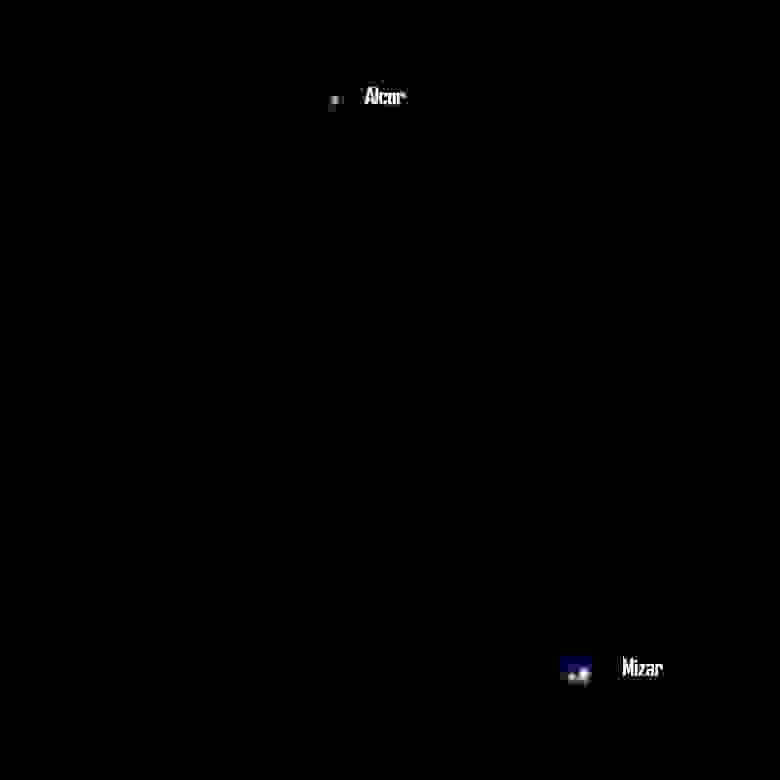
Is it possible for two stars that are 3 light-years apart to be gravitationally bound?
Whether or not they are gravitationally bound depends on the masses of the stars.
The Sun and the Alpha Centauri triple system are separated by a slightly greater distance of 4.4 light-years and are not considered to be physically connected. However, these stars are relatively low in mass. The Sun’s gravitational influence extends to a sphere with a radius of about 1 light-year, which can be used as a rough estimate.
What do we know about the masses of Alcor and Mizar?
When we mention these two names, we are not referring to just two stars, but rather six stars in total. Alcor is actually a close binary star, while Mizar can be easily split into two and is even a quadruple star when observed through a small telescope. What we are interested in is the combined mass of this remarkable stellar system.
Each of the four components of the multiple star system Mizar has a mass twice that of the Sun, and the mass of Alcor, along with its companion, is more than two times the mass of the Sun.
In total, we have a star system that is ten times the mass of the Sun. The characteristic radius of gravitational influence can be determined by taking the square root of the mass ratio.
The square root of ten is greater than three.
It appears that the interaction between Mizar and Alcor must still exist, despite being 3 light years apart. This is further supported by their parallel motions in space – Mizar and Alcor are not flying away from each other, but rather keeping pace.
How uncommon is this scenario?
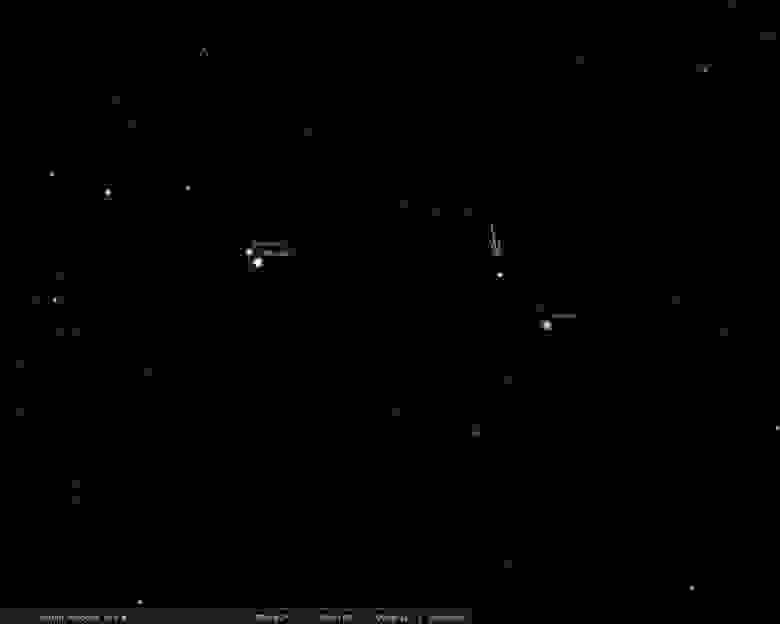
But what about the other stars in the pail?
Here’s where we get to the most fascinating part. The majority of the stars in this constellation (excluding the ones on the outer edge) are situated at the same distance from us. As they appear on the celestial sphere, they form a flat silhouette of a pail. However, in actual three-dimensional space, they are positioned as if they were drawn on a two-dimensional plane.
This is a remarkable example of a star cluster that maintains its shape regardless of the viewer’s perspective. Even when viewed from the opposite side, it remains the same image, acting as a mirror reflection of itself, still resembling a pail.
Five out of the seven prominent stars in the Big Dipper pail are located at the exact same distance – 80 light-years away. Only Dubhe and Benetnash are slightly further, at 123 and 100 light-years respectively. However, this slight variance is not significant on an interstellar scale.
The stars in the Big Dipper not only have the same distance from the Sun, but they also possess similar physical attributes – identical age and chemical composition, comparable masses and luminosities, and most intriguingly, they travel together in the same direction as a collective.
When observing the Big Dipper, we are actually looking at a vast star cluster that spans over half of the constellation. This cluster consists of stars that originated from the same area in space around 300 million years ago and are now journeying through the Galaxy as a synchronized group. The majority of the stars in the Big Dipper are siblings. In addition to the prominent stars in the handle of the celestial ladle, some stars in the head and paws of the constellation also partake in this coordinated flight.
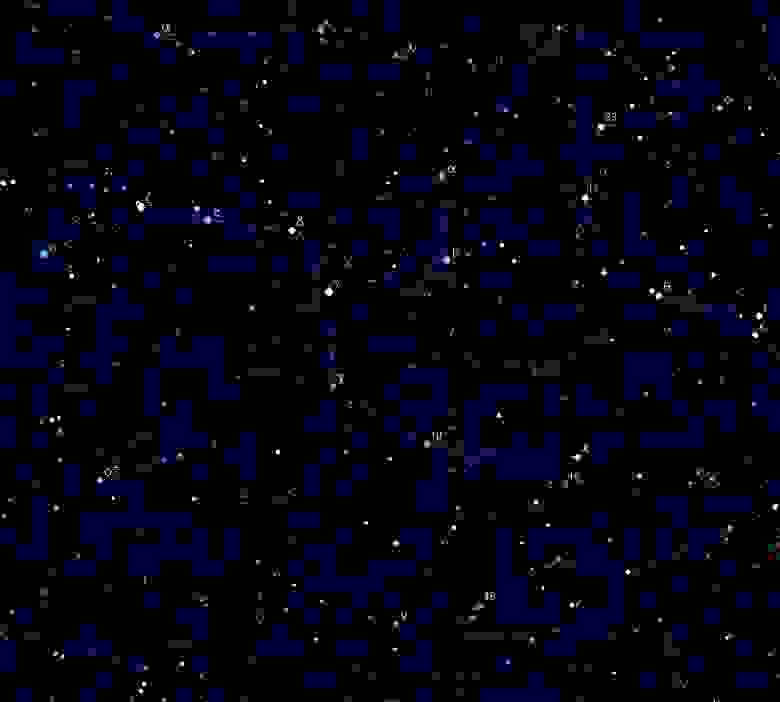
Some stars in the sky have a unique and ironic position, reflecting the complexity of the Universe.
Revisiting Mizar and Alcor
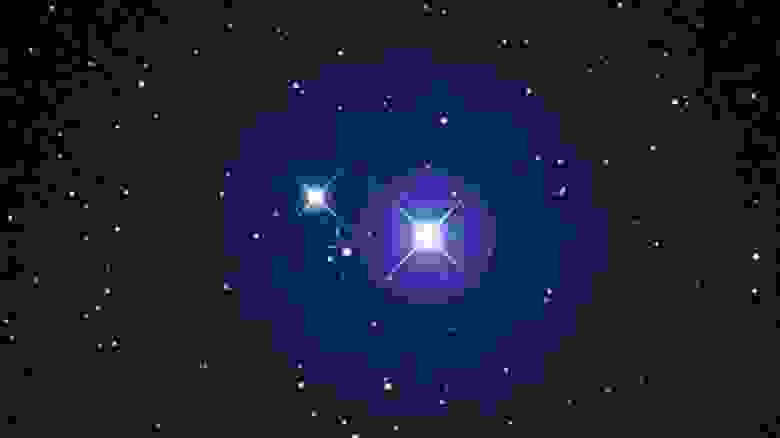
At the conclusion, I have a musical surprise for everyone who has reached this point. A composition dedicated to two celestial bodies – Alcor and Mitsar – from my album “Star Bridge”.
The Great Bear (also known as Ursa Major) is a constellation located in the northern hemisphere of the celestial sphere. The seven stars that make up the Great Bear form a shape resembling a ladle with a handle. The two brightest stars, Aliot and Dubhe, have an apparent sidereal magnitude of 1.8. By following a line from the two outermost stars (α and β), you can locate Polaris. The best visibility conditions are during the months of March and April. The Great Bear can be seen throughout Ukraine and Russia.
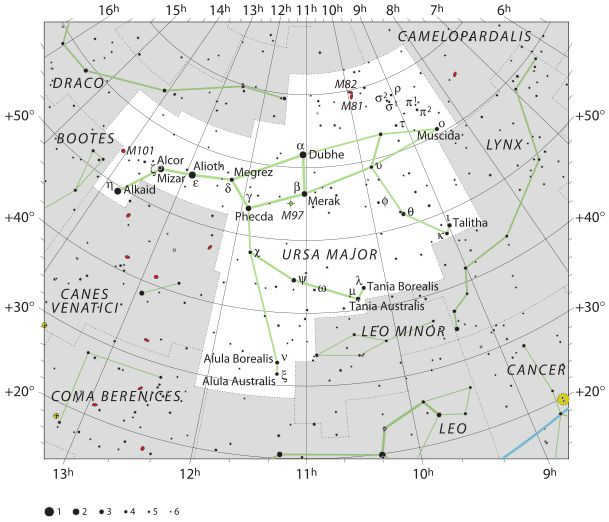
Click the picture to make it larger
Constellations
Ursa Major – the third largest constellation in terms of area, consisting of seven bright stars that form the well-known Ursa Major. Ursa Major This group of stars has been recognized since ancient times by various cultures with different names: The Plow, The Elk, The Wagon, The Seven Sages, and so on. All the stars in the Big Dipper have their own Arabic names: Dubhe (α of Ursa Major) means “bear”; Merak (β) means “loins”; Feqda (γ) means “thigh”; Megretz (δ), “beginning of the tail”; Alioth (ε) – the meaning is unclear; Mizar (ζ) – “girdle” or “loincloth”. The final star in the handle of the Dipper is called Benetnash or Alkaid (η); in Arabic, al-kaid banat nash means “leader of the mourners”. This poetic image is derived from the Arabic folk interpretation of the Ursa Major constellation. The system of assigning Greek letters in descending order of brightness to the Dipper is arbitrary: the order of the letters simply corresponds to the order of the stars.
There is another way to interpret the asterism, which is also known as hearse and Mourners. In this interpretation, the asterism is likened to a funeral procession with the mourners following behind a leader, who is symbolized by the star η of the Big Dipper and is referred to as the “leader of the mourners.”
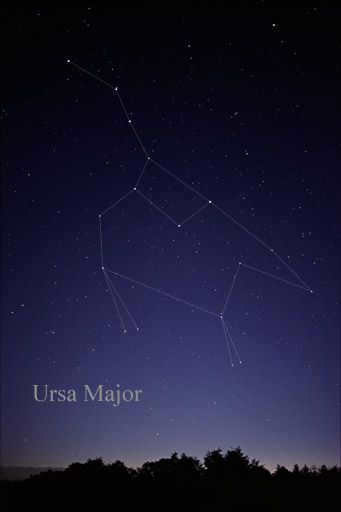
Interestingly, the five inner stars of the Big Dipper (excluding the outermost α and η ) actually form a cohesive cluster in space – the mobile cluster of the Big Dipper (also known as the Sirius super cluster), which moves quite rapidly across the celestial sphere; Dubhe and Benetnash are moving in the opposite direction, causing the shape of the Big Dipper to change significantly every 100,000 years.
The stars Merak and Dubhe, which create the boundary of the Big Dipper, are known as the Pointers because a line connecting them points towards Polaris (located in the Little Dipper constellation). Every star in the Big Dipper has a brightness of 2 or 3 magnitudes.
A celestial pattern named “The three jumps of the gazelle” originates from Arabia. It is composed of three pairs of closely grouped stars, positioned in a straight line and evenly spaced apart. This asterism represents the hoofprints left by a gazelle as it leaps and bounds through the sky. The stars included in this constellation are:
– Alula North and Alula South (ν and ξ, representing the first leap)
– Taniyah North and Taniyah South (λ and μ, symbolizing the second jump)
– Talitha North and Talitha South (ι and κ, signifying the third leap)
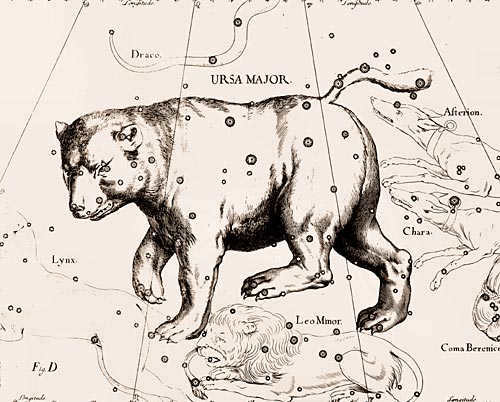
The illustration showcases the appearance of the Big Dipper constellation as depicted in the Atlas Uranographia by Jan Hevelius in 1690. Feel free to click on the image to get a closer look at it.
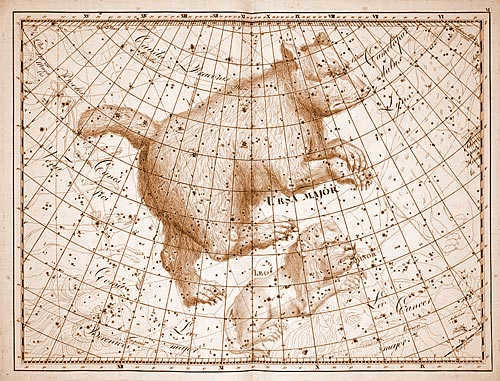
The constellation known as the Big Dipper can be observed in the Atlas titled “Uranographia” created by J. E. Bode in Berlin in 1801.
Feel free to click on the image to get a closer look.
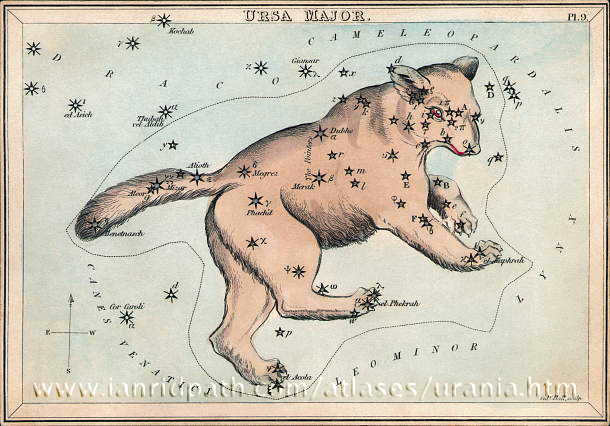

The constellation known as the Big Dipper can be seen in the Atlas titled “Urania’s Mirror” that was published in London in 1825.
There are numerous galaxies and galaxy clusters located within the region of the Big Dipper. One example of a spiral galaxy is M 101, which appears flat when observed. On the other hand, the spiral galaxies M 81 and M 82, which are positioned close to each other at an angle of only 38', are believed to form the core of the nearest galaxy group to us, located approximately 7 million light-years away. However, the Owl nebula (M 97), which is one of the largest planetary nebulae, is much closer to us, as it is situated within our own Galaxy. In 2002, astronomers from the University of Texas at Arlington made a groundbreaking discovery by identifying two exoplanets orbiting the star 47 in the Big Dipper.
Historical Background
This constellation has a long and ancient history. It was first documented in the catalog of the starry sky known as “Almagest,” which was compiled by the famous Greek astronomer Claudius Ptolemy.
According to Greek mythology, the constellation represents the transformed figure of a beautiful nymph named Callisto. In order to protect her from the wrath of the goddess Hera, Zeus turned Callisto into a Medusa. Additionally, there is another myth recounted by Philemon of Syracuse, which tells the tale of two Cretan nymphs who were also transformed into bears by Zeus as infants. These bears were then placed in the sky as the constellations of the Big and Little Bears.

Callisto (Greek Καλλιστώ) – in Greek mythology, she was an Arcadian woman and the daughter of Lycaon. She was one of the companions of Artemis, the goddess of hunting. However, she was punished by being transformed into a bear because she failed to remain a virgin. As a bear, she gave birth to Arcadus and Pan. Another version of the story suggests that Zeus, disguised as Artemis, turned her into a beast to protect her from the jealousy of Hera.
When Arcades, who was unfamiliar with her and was raised by Maia or Hermes, desired to end her life, Zeus transported both of them into the heavens as constellations: Callisto became the Big Dipper, while Arcade became Arctophylacus (the Guardian of the Bears, now known as Wolopassus) or the star Arcturus within that constellation. Hera, consumed with anger, denied Callisto the chance to refresh herself in the ocean waves during part of the day; hence, the Big Dipper never sets.
Depicted here is a painting – François Boucher’s “Callisto and Jupiter Zeus takes the image of Artemis.”
In Chinese astronomy, the seven stars of the dipper are referred to as the Northern Bucket (Beidou). In ancient times, the handle of the bucket pointed almost directly at the pole and was used by the Chinese to determine the time.
The constellations of the Big Dipper, the Little Dipper, Volopassus, and the Hound Dogs are linked by a common myth that continues to captivate us with its tragic tale. In ancient times, King Lycaon ruled over Arcadia, and his daughter Callisto was renowned throughout the world for her charm and beauty. Even Zeus, the ruler of Heaven and Earth, was taken aback by her divine allure upon first laying eyes on her. Despite his jealous wife, the mighty goddess Hera, Zeus secretly visited Callisto in her father’s palace. It was during these clandestine encounters that Callisto bore a son named Arcades, who grew up to be a skilled and handsome archer, often venturing into the forest for hunting expeditions. Hera eventually discovered Zeus and Callisto’s forbidden love and became enraged, transforming Callisto into a hideous bear. When Arcades returned home from a hunt one evening, he encountered the bear within the house and, unaware of its true identity, drew his bowstring. However, Zeus intervened, preventing Arcades from committing a grave offense. In a swift motion, Zeus seized the bear by its tail and carried it into the sky, transforming it into the constellation we now know as the Big Dipper. During this journey, the bear’s tail began to elongate, resulting in the Big Dipper’s distinctive long and curved shape. Understanding the deep bond between Callisto and her handmaiden, Zeus also brought her to the heavens, shaping her into the small yet beautiful constellation of the Little Bear. As for Arcades, Zeus elevated him to the stars as the constellation Volopassus. Forever bound to protect his mother, the Big Dipper, Volopassus steadfastly holds the leashes of the Hound Dogs, who bristle with fury and stand ready to attack and tear apart the Big Dipper.
There exists a different variation of this legend. The perpetually youthful goddess Artemis, adorned in hunting attire and armed with a bow, quiver, and sharp spear, roamed through the mountains and forests for an extended period in search of worthy prey. Her companions and handmaidens followed her, filling the mountain peaks with laughter and song. Among the girls, Callisto stood out as the most captivating. When Zeus caught sight of her, he was captivated by her youthful appearance and beauty. However, Artemis’ attendants were forbidden from marrying. In order to possess her, Zeus employed a cunning plan. One night, disguised as Artemis, he presented himself before Callisto. As a result of this encounter, Callisto gave birth to a son named Arcades, who rapidly matured and became an unmatched hunter. Zeus’ jealous wife, Hera, upon discovering her husband’s affair, directed her anger towards Callisto, transforming her into an unsightly and awkward bear. One day, Callisto’s son Arkad was wandering through the forest when he encountered a bear emerging from the bushes. Unaware that it was his mother, he drew his bowstring and released an arrow towards the bear. However, Zeus, protecting his beloved Callisto, deflected the arrow at the last moment, causing it to miss its mark. Simultaneously, Zeus transformed Arkad into a small bear cub. Zeus then grasped both the bear and the cub by their tails and carried them into the sky. There, he positioned Callisto to shine as the resplendent constellation known as the Big Dipper, and Arkad as the constellation of the Little Dipper. Callisto and Arkad became even more magnificent in the heavens as constellations than they had been on Earth. Not only did mortals admire them, but Zeus himself. From atop Mount Olympus, he frequently gazed upon the constellations of the Big and Little Dipper, reveling in their beauty and their perpetual movement across the sky. Hera grew uneasy when she witnessed her husband admiring his favorites. She fervently beseeched the god of the sea, Poseidon, to prevent the Big Dipper from ever touching the sea. Let it perish from thirst! However, Poseidon ignored Hera’s pleas. How could he allow the beloved of his brother, the mighty Zeus, to die of thirst?! The Big Dipper continues its celestial journey around the pole, descending low over the northern horizon once a day to touch the surface of the sea, quenching its thirst, and then rising once more, captivating the gaze of both mortals and gods with its magnificence.
Legend has it that the constellation Volopassus is a representation of the initial farmer, Triptolemus. Demeter, the goddess of fertility and agriculture, presented him with an ear of wheat, a wooden plow, and a sickle. She instructed him on the techniques of plowing the land, sowing wheat grains, and harvesting the ripe crops with the sickle. The first field that Triptolemus sowed yielded a bountiful harvest. In accordance with the wishes of the goddess Demeter, Triptolemus shared the secrets of farming with the people. He taught them how to cultivate the land and honor the goddess Demeter, in hopes of receiving abundant fruits as a reward for their labor. As a reward for his efforts, Triptolemus was transformed into the constellation Volopas and given tireless oxen, represented by bright stars in the Big Dipper constellation. With their assistance, he tirelessly plowed and sowed the sky. When the constellation of Volopas, the plowman, reappeared in the east after a period of invisibility in early spring, people would begin preparing for their spring fieldwork.
The Bulgarian people have given the beautiful constellation of the Big Dipper the name Wagon. According to a legend, a young man once went into the forest to cut wood. He arrived in the forest, untied his oxen, and let them graze. Suddenly, a bear emerged from the forest and devoured one of the oxen. The brave young man managed to capture the bear and placed her in the wagon as a replacement for the eaten ox. However, the bear was unable to pull the wagon, causing it to sway from side to side. This is why the wagon appears crooked in the constellation. Within the Big Dipper, the elderly people associate the individual stars in the following manner: the star η represents the Charioteer, the star Mizar (ζ) represents the Bear, the star ε represents the Vol, and the star Alkor represents the dog that barks at the Bear. The remaining stars form the Carriage itself. Due to the similar geometric figures in the constellations of the Big and Little Bear, the Bulgarian people also refer to the constellation of the Little Bear as the Little Wagon.
Did you know?
An interesting fact about Alaska is that the constellation of the Big Dipper is actually depicted on its flag.
The Flag of Alaska is an important symbol of the state of Alaska in the United States.
It was designed in 1926 by a 13-year-old Alaska Native named Benny Benson and was officially adopted as the symbol of the Territory of Alaska in 1927. Alaska became a state on January 3, 1959.
The flag features a blue background with eight gold (yellow) five-pointed stars. These stars represent the Big Dipper constellation and Polaris, the North Star, which is located in the upper right corner.
The Big Dipper symbolizes power, while Polaris symbolizes the northern location of Alaska, as it is the northernmost territory of the United States.
Here’s a step-by-step drawing tutorial on how to sketch the Big Dipper using a pencil. The Big Bear is a constellation that has the shape of a dipper with a handle. The Big Dipper is made up of seven stars, with two of them being particularly bright. This constellation is almost always visible to us at night, and we can easily identify it by its distinctive features.
Now, let’s take a closer look at its appearance.
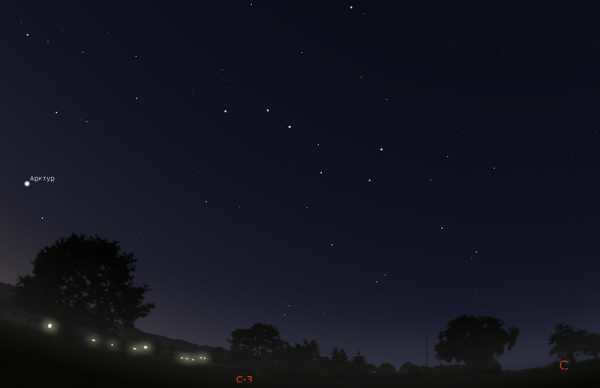
Creating this constellation is a simple task. Initially, you must sketch two dots on a slight incline, then incorporate two additional dots at a similar distance from the first ones, but slightly to the left and right. This shape bears a resemblance to a trapezoid.
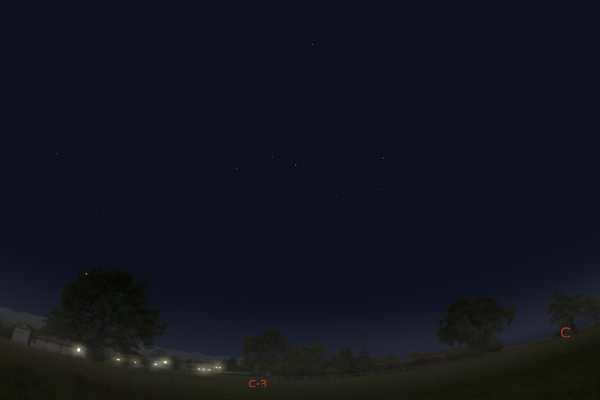
Next, we should position the following star, which will serve as the grip. It should be placed closest to all the other stars and in a straight line from the far-left star.
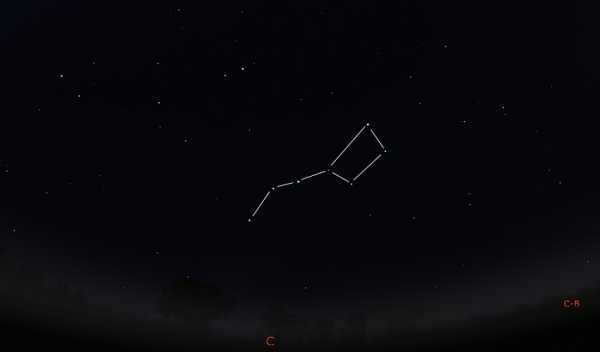
Next, we must add two additional stars in the shape of dots.
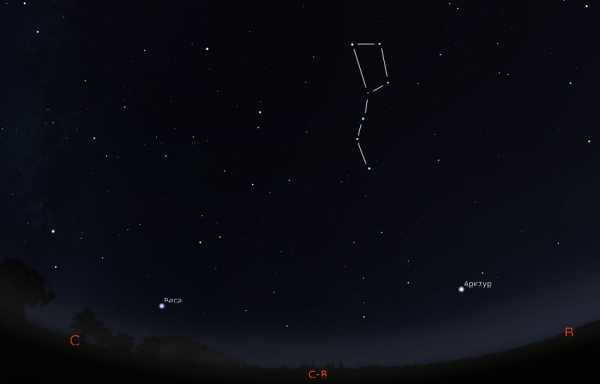
Presented here is the celestial formation known as the Great Bear. By drawing lines between the stars, an intriguing shape resembling a bucket with a handle emerges.
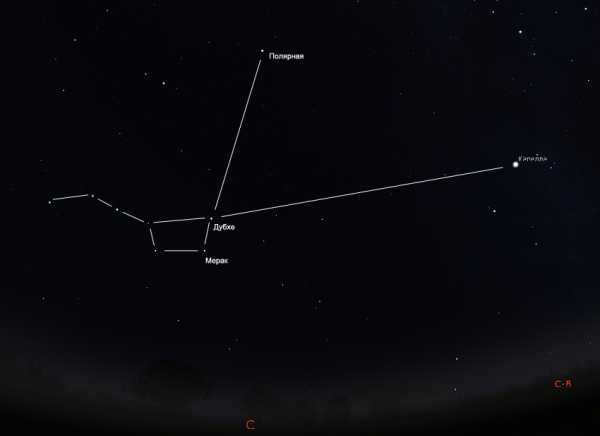
Among the numerous constellations in the sky, one that stands out is the “Little Bear”, which resembles the Big Bear and has Polaris as its brightest and final star. You can refer to the image below for a visual representation. Interestingly, this constellation is visible throughout the year, making it easy to locate once you have found the Big Bear.
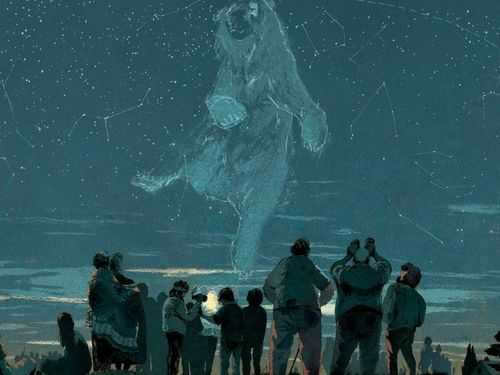
You might find the following lessons interesting:
1. A tutorial on drawing the solar system
2. A guide on drawing planet Earth
How to sketch a constellation 🚩 and create a model of the Great Bear 🚩 Drawing
Most constellations are made up of small stars that are not part of the main asterism. These stars are usually not named and are only designated by Greek letters. This means that they don’t contribute to the overall shape or meaning of the constellation’s image. However, if you are drawing a constellation and not just a mythical character with dots or lines, it’s important to include these small stars in or near the drawing.
When it comes to labeling the stars that form an asterism, they are typically prioritized. However, even this may not provide the artist with any inspiration for their drawing. For instance, the asterism of the Hound Dogs constellation, which is located near the Big Dipper, is composed of just two stars, offering no clear image or suggestion to the artist. On the other hand, there are numerous galaxies and globular star clusters that can offer a wider range of options for the artist’s imagination, allowing them to be less constrained by mythological themes.
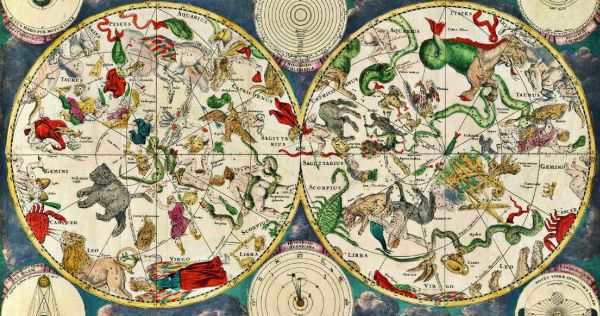
The group of stars known as the Big Dipper, also referred to as the bucket, consists of various stars including Dubhe (alpha), Merak (beta, etc.), Fekda, Megrets, Aliot, Mitsar (and Alcor(a)) and Benetnash at the end of the bucket. Additionally, there are approximately twenty-four other stars that form part of the Big Dipper constellation. When creating a depiction, it is important to accurately represent the positions of the stars in the asterism. As for the rest of the drawing, it is up to your own discretion. You may choose to connect the stars with lines, indicate their magnitudes, depict star systems such as Mizar and Alcor, or even include dust clouds, nebulae, and galaxies. You can also decide which stars to include “inside” the asterism. However, if you decide to incorporate other stars outside of the asterism, it is necessary to provide their precise locations and potentially other characteristics if they were used in plotting the main stars.
Nonetheless, their size is roughly equivalent to that of the Sun, which means they are rarely visible to the naked eye within the Russian Federation’s borders and only in specific geographic locations. However, this does not preclude their inclusion in constellation depictions! All one needs is a star chart, which displays far more stars than can be observed in the northern hemisphere.
Regarding the actual depiction of a constellation, it is customary to render only a slightly blurred outline of the figure, ensuring its symbolism remains clear. The coloring, detailing, and even a distinct outline of the constellation are no longer considered appropriate: these types of depictions are remnants of medieval tradition.
The Incredible Bear (Spinning Model) The Realm of Experts
When my son was in the first grade, he had a project in his “world around us” class to observe and draw the changing position of the Big Dipper constellation in the sky during different seasons. To make it easier, we used a user-friendly program that allows you to create a map of the starry sky. You simply enter the point of observation, date, time, and the part of the sky you want to explore (south or north), and the program generates the desired constellation. However, my son couldn’t grasp the concept this way. He needed to truly understand it. So, I searched for explanations that would be suitable for a child’s comprehension and stumbled upon a helpful website. I highly recommend visiting http://www.astrogalaxy.ru/kind11.html. Inspired by this newfound knowledge, we decided to create a rotating model of the Big Dipper. Here’s how it turned out.
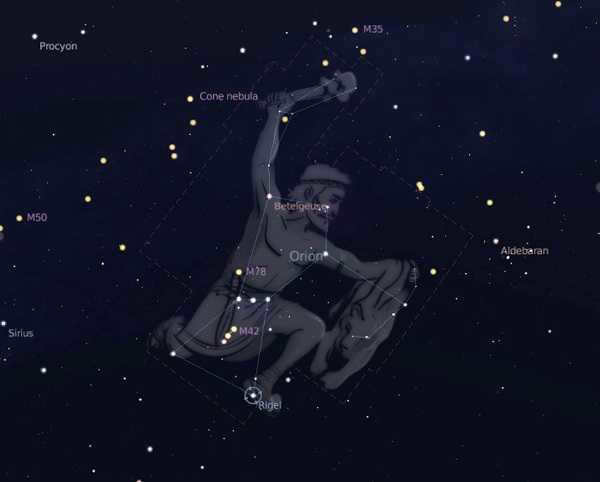
At present, my son simply has to position the constellation correctly within the designated sector (as shown in the photograph under the “spring” position) and sketch it. He managed to accomplish this task on his own, demonstrating his natural aptitude. Furthermore, the reasons behind its rotation have become apparent – it is visually captivating, aesthetically pleasing, and therefore captivating, giving the impression of autonomous work and astronomical discoveries.
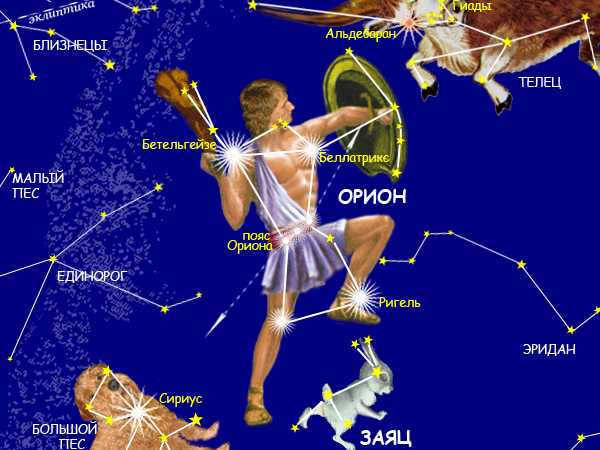
And here we have the season of “winter” and some poems, which have been taken from the aforementioned website. I have made a few changes to them (hopefully the authors will forgive me).
Our beloved planet Earth
(We all know it, of course!)
Spins around each day and year
Taking its turn.
And from this Earth
♪ And from this Earth
We realize it’s not the Earth that’s spinning
But rather all the stars and the moon.
Except for the POLAR STAR
It doesn’t move from its place!
In every season of the year
At the center of the circle
You can always find it
If you happen to lose your way.
The axis of the Earth
# It’s always pointing at it
You can always be certain
That it’s located in the NORTH!
That star is more than just a dot
It’s the tail of the Big Dipper!
The starry nose of Ursa Major
Will always point directly at it!
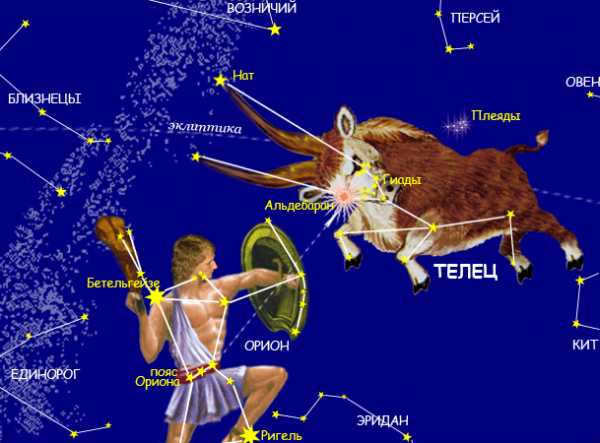
It is currently autumn. For children who are curious about the night sky, here is an interesting fact: as the Earth orbits around the Sun, the position of the stars in the sky appears to change. This is why the Big Dipper, a constellation shaped like a dipper, also seems to rotate and move throughout the year.
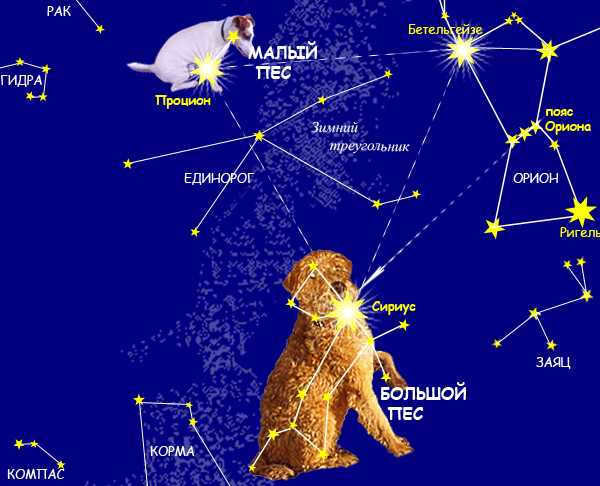
All that remains is to create a design for it. The legends regarding the Great Bear are depicted on the left side. Finally, I have discovered the explanations to the inquiries that have plagued me for a while: why the bear was spotted in the ladle, why it appears so intimidating on ancient celestial charts, and why it has a lengthy tail. Additionally, who is the Lesser Bear. The narrative is both captivating and sorrowful…
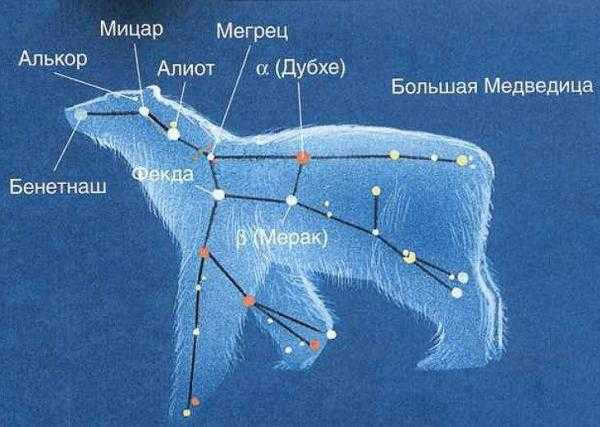
This is the cover page. The constellation and its primary stars. Also featuring poems (modified by myself).
THE GREAT BEAR
I can identify it by its COVE!
Seven stars shine bright here,
And these are their names:
DUBHE illuminates the darkness,
Beside it, MERAC burns,
And on the side, there are FEKDA and MEGRETZ,
That is how the Creator arranged them.
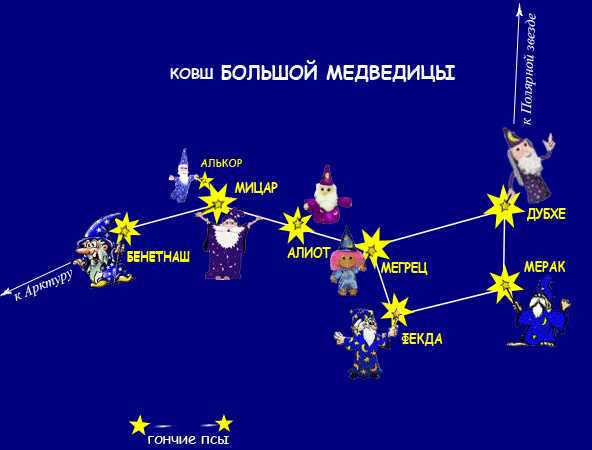

The piece of art (or rather an abstract on the topic) is created using black watercolor paper. I sketched on it with a silver gel pen – the result is truly stunning, as the lines and letters shimmer in silver. “Stars” – taken from a Christmas tree decoration (leftover from the Snow Maiden project https://stranamasterov.ru/node/115169 ). Of course, it wasn’t very tidy, as the idea came unexpectedly, and it was crafted in one evening and half of the night. Overall, it serves as visual material for the lesson, rather than a gift or a competition entry.
In general, my son enjoys creating something extra related to the “surrounding world”.
We moved on from computers – he made a computer desk https://stranamasterov.ru/node/115578.
After that, it was snow – he made a quilling snowflake (even his teacher hung it on the classroom tree).
Dinosaurs – he created a family of triceratops using plasticine, placed them inside a container, adorned them with grass-like material, added a toy bush, and achieved a result of 5+.
Moreover, stars and space hold a special fascination for him, so he found it incredibly captivating to explore this subject through his own model. He sketched, positioned constellations in various ways, quickly memorized a star-themed poem on his own, and enthusiastically delved into mythical stories, engaging in discussions such as, “Mom, do you think the Bears felt pain when they stretched their tails? They must have roared.”
PS: I’m providing detailed information not necessarily for experts (as there is no artistic aspect here), but rather for first-grade moms (and others). Many parents (not to mention the children) in our class struggled with this task and theme, but Max and I found it so fascinating.
Constellation of the Big Dipper – presentation, report, project
Feedback
If you were unable to locate and download the report-presentation, you have the option to request it on our website. We will make an effort to locate the material you require and deliver it via email. Do not hesitate to reach out if you have any inquiries or demands:
Do not hesitate to reach out if you have any inquiries or demands:
We have a presence on social media
Social media platforms have become an indispensable aspect of our daily lives. They serve as a source of information, a means of communication with friends, and a platform for engaging in interactive hobby communities.
What is Myslide.ru all about?
Myslide.ru is a website dedicated to hosting and sharing presentations, reports, and projects in PowerPoint format. Our platform aims to assist educators, students, and professors in storing and exchanging educational resources with fellow users.
Constellations – lesson. Environment, 2nd grade.
Stars are celestial bodies that are round in shape and have the unique ability to emit light. They are composed of gas and particles.
In the past, when individuals gazed at the nighttime sky, they observed numerous luminous stars arranged in a particular pattern, creating clusters. These clusters are known as constellations. This term originates from a Latin word meaning “group of stars.”
A constellation refers to a collection of stars that share a common designation.
In various ancient societies, individuals assigned names to these constellations, often naming them after gods, heroes, or using the names of animals or well-known objects.
Orion is a prominent constellation situated on the celestial equator. It is named after a legendary hunter from ancient Greek mythology. Orion’s belt is composed of three stars.
Cassiopeia is a constellation located in the northern sky. It is named after a vain and boastful queen from ancient Greek mythology. The primary stars of the constellation form the shape of the letter “M”. In the spring and summer seasons, this letter appears inverted.
Pegasus is a constellation found in the northern hemisphere and is known as one of the largest in the night sky. It is named after the winged horse of ancient Greek mythology. The constellation can be identified by the prominent Great Square of Pegasus.
Andromeda is a constellation situated in the northern sky between Cassiopeia and Pegasus. It is named after the mythical princess Andromeda.
Perseus, the constellation situated adjacent to Andromeda in the northern celestial sphere, derives its name from the legendary figure in Greek mythology, Perseus. Notably, it is renowned for hosting the Perseids meteor stream.
Swan, a highly prominent constellation found in the northern sky, bears a striking resemblance to a flying swan with its wings gracefully spread out. The swan’s tail is identified by a luminous star, one of the brightest celestial objects.
Leo, a constellation occupying a substantial portion of the northern sky, is a member of the zodiacal group of constellations. Depicting an animal, it is often associated with the Nemean lion from the mythological tales of Hercules’ extraordinary feats.
The Great Bear
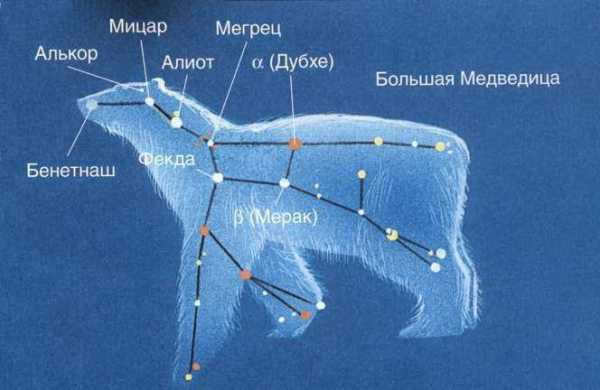
ENJOY THE BENEFITS WHILE HAVING FUN!
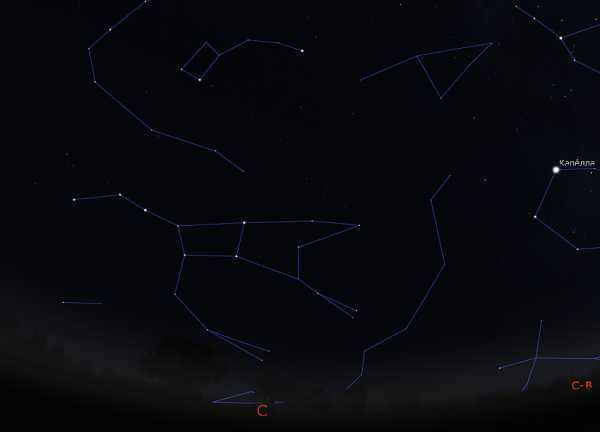
Objective
Locate the position of the Ursa Major and the Ursa Major in the spring.
- During daylight hours, utilize a compass to determine the direction of the north.
- Discover the spot that offers you the optimal view of the northern region of the celestial sphere.
- On a clear night without moonlight, venture outdoors and position yourself in the appropriate location facing north.
- Commencing from the Ursa Major, identify the remaining stars within the constellation Ursa Major.
You will have the opportunity to observe the Ursa Major and some of the other stars within the Ursa Major constellation.
Locating all the stars in the Big Dipper may not always be a simple task, but fortunately, the Big Dipper itself makes the process much more convenient. The most opportune time to embark on this celestial treasure hunt is during the spring season when the constellation sits prominently above the horizon.
ADDITIONAL FASCINATING TIDBITS ABOUT OUR CELESTIAL NEIGHBORS!
The Large Container can assist you in locating Polaris at any point in the year. Merely connect the two outer stars of the container with an imaginary line and extend that imaginary line beyond it. The subsequent star you observe on this direct line is Polaris. (Keep in mind that Polaris is not particularly luminous.) The star diagram depicted in this illustration will aid you in finding Polaris utilizing the Large Dipper on the initial day of each season at 9 PM. However, throughout the night, or at the same time but in different seasons, the group of stars moves in a counterclockwise direction around Polaris. Regardless of the positioning of the Large Dipper in the celestial sphere, its stars always indicate Polaris.
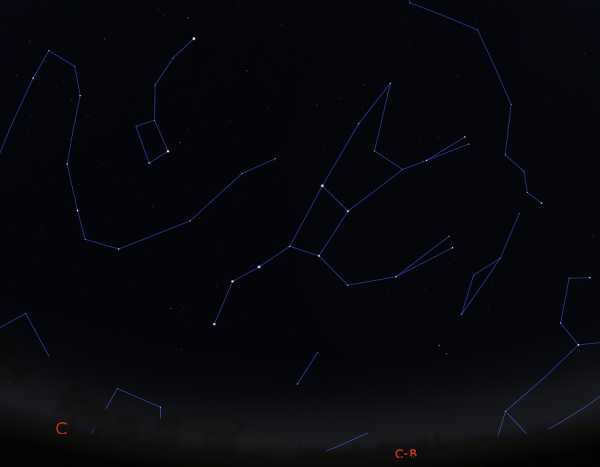
Based on the book The Big Book of Scientific Fun by Janice VanCleave
Add a comment
Constellations pictures for kids
Children’s interest in constellations has made it an ideal topic for our lessons. Astronomy for kids is a subject that bridges the gap between reality and fantasy. The night sky captures children’s fascination, inspiring them to explore the world, the cosmos, and seek information from various sources. It also enhances their memory and abstract thinking skills.
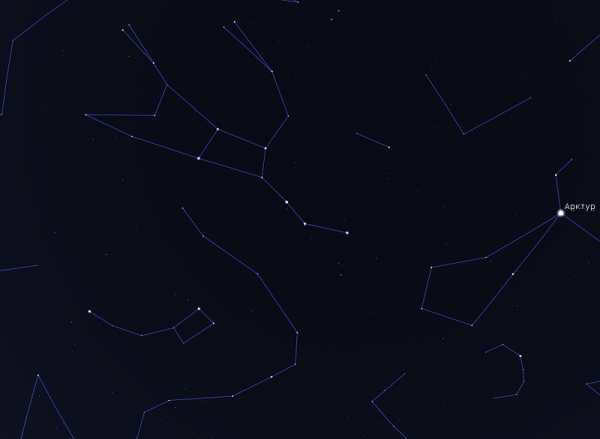
Expanding a child’s thinking and increasing their interest in new academic disciplines and discoveries can be achieved through familiarity with the world around us and the structure of the universe.
Constellations pictures for children
When introducing complex concepts to a child, such as:
it is important to incorporate as much visual material as possible and allow them to engage in hands-on activities. Therefore, for preschool children studying the cosmos, we suggest conducting an engaging lesson using didactic cards.
To do this, you will need to create two types of cards: one with images of constellations and the other with their names. You can print out pictures from the computer and attach them to cardboard, or even draw the constellations yourself. Additionally, writing a brief legend about the origin of each constellation on the cards with their names can add an extra educational element.
Arrange the cards featuring the stars and their names. Examine them with your child, take note of the constellation shapes, and discuss the origins of their names. Envision other possible arrangements of these stars.
Next, mix up the cards. Encourage your child to independently match the names with the constellation pictures. Offer assistance if needed. This activity is excellent for enhancing your child’s memory.
Cards featuring star constellations
Images of constellations for young children 1
Illustrations of constellations for young children 2
Pictures of constellations for young children 3
Artwork of constellations for young children 4
Starry images of constellations for kids 5
Star-themed pictures of constellations for kids 6
Visual representations of constellations for kids 7
Graphics of constellations for kids 8
Illustrations of constellations for kids 9
Artwork of constellations for kids 10
Images of constellations for kids 11
Illustrations of constellations for young children 12
Create your own drawings of your favorite constellations. Secure them to a large sheet of paper or mount them on a board to create your very own starry sky.
You have the ability to create a representation of the star-filled sky on a sheet of paper. During this process, you can explain to your child that constellations are not the same in every location, as the night sky appears differently in the northern and southern hemispheres. If your child enjoys drawing, encourage them to use their imagination and invent their own constellations with unique names – this type of activity is highly engaging for children and also helps to foster their creativity.
The concept of constellations becomes even more tangible for children when you show them some of the stars they have learned about in the night sky. This often sparks a deep interest in understanding the structure of the universe.
To analyze the sentences in a text, input the text into the designated box and click the analyze button.
How does the program analyze sentences?
The program dissects the entire text into individual words and sentences, then analyzes each word separately, identifying its morphological features and initial form.
Feel free to evaluate our program below and leave comments. We will make sure to respond.
- Show all 9
- Verb in the first person form 1
- Noun 3
- Preposition 1
- Adverb 1
- Conjunction 1
- Infinitive 1
- Adjective 1
- D Insert
- Word analysis
- Option 1:
- Part of speech: Verb in the first person form
- Initial form: INSERT.
- All characteristics
Second person Active Voice Plural Imperative (imperative) Transitive Perfect
- Word parsing
- Variant 1:
- Part of speech: Preposition
- Initial form: In
Adjective (not used) Singular Name Masculine Animate Prepositional case
Dative case Adjective (not used) Singular Feminine Toponym Inanimate
- JUDGEMENT to
- Word parsing
- The word can be parsed in 2 variants
- Variant 1:
- Part of speech: Union
- Initial form: WHEREAS.
- Variant 2:
- Part of speech: Particle
- Initial form: WHEREAS.
Characterization of the sentence
About the tool
Once you click the “Parse” button, the tool will provide you with the syntactic parsing outcome of the given sentence. The result will include the total number of characters and words in the text.
Each part of speech is distinguished by a unique color. To view only specific parts of speech in the sentence, simply select the desired part from the toolbar.
What is the best choice for parsing?
Homonyms are words that have the same spelling but different meanings. These words can appear in a sentence and the program may not be able to determine the intended meaning. In this case, you need to choose the correct parsing of the word in the sentence by considering the context.
To do this, you can use the morphological features of the word. Simply hover over the word and select “All Characteristics” from the dropdown menu to view them.






